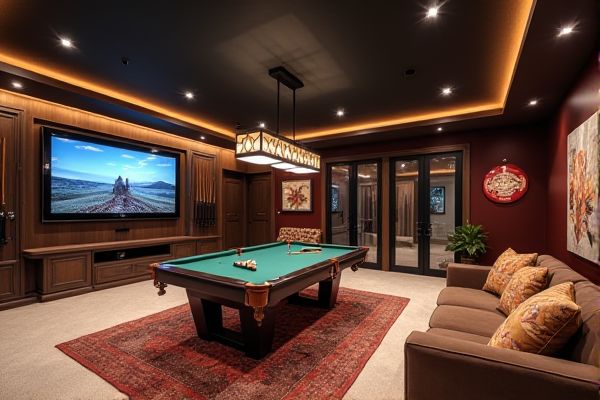
A game room offers entertainment and relaxation through activities like video games, billiards, or board games, creating a social hub in your basement, whereas a home gym focuses on fitness equipment and exercise, promoting health and physical well-being. Discover how transforming your basement into either space can enhance your lifestyle by reading the rest of this article.
Table of Comparison
| Feature | Game Room | Home Gym (Basement) |
|---|---|---|
| Primary Purpose | Entertainment and socializing | Fitness and exercise |
| Equipment | Video games, pool table, arcade machines | Weights, treadmill, exercise machines |
| Space Utilization | Open area for games and seating | Designated zones for workouts and stretching |
| Climate Control | Basic HVAC for comfort | Enhanced ventilation and humidity control |
| Noise Level | Variable; usually lively | Can be loud due to equipment but controlled |
| Lighting | Ambient and mood lighting | Bright, focused lighting for safety |
| Flooring | Carpet or hardwood | Rubber mats or cushioned flooring |
| Maintenance | Low to moderate | Moderate, equipment upkeep required |
| Health Benefits | Relaxation and stress relief | Improved fitness and well-being |
| Cost | Moderate depending on equipment | Higher initial investment for machines |
Game Room vs Home Gym Basement: Which Suits Your Lifestyle?
Choosing between a game room and a home gym basement depends on your lifestyle priorities and fitness goals. A game room enhances social interaction and leisure with entertainment systems, while a home gym promotes health, convenience, and consistent workouts within your personal space. Your decision should align with whether you value relaxation and fun or physical wellness and active living.
Space Requirements: Game Room or Home Gym?
A game room typically requires open space for entertainment systems, seating, and gaming tables, often needing at least 200 square feet for comfortable use. A home gym demands more versatile space to accommodate equipment like treadmills, weights, and mats, usually requiring 300 to 500 square feet to ensure safety and effective workouts. Optimizing basement layouts depends on ceiling height, ventilation, and flooring durability to suit either recreational or fitness activities.
Cost Comparison: Setting Up a Game Room vs Home Gym
Setting up a game room in your basement typically involves lower initial costs, with expenses centered around entertainment systems, seating, and decor, often ranging from $1,000 to $5,000. In contrast, creating a home gym demands a more significant investment for quality equipment, flooring, and possible installation, commonly costing between $2,000 and $10,000 or more. Your budget decisions should consider equipment durability, space functionality, and long-term maintenance costs for a balanced comparison.
Equipment and Furnishings: Essentials for Each Space
A game room typically features entertainment-focused equipment like gaming consoles, comfortable seating such as recliners or bean bags, and specialized lighting to enhance the atmosphere. In contrast, a home gym basement requires durable fitness equipment including weights, cardio machines, and mirrors for form correction, along with non-slip flooring to ensure safety during workouts. Your choice between these spaces should reflect the essentials needed to support either relaxation and recreation or effective exercise and physical training.
Family Appeal: Entertainment vs Fitness
A game room in the basement offers a vibrant space for family entertainment, fostering bonding through activities like video games, board games, and movie nights. In contrast, a home gym promotes health and wellness by providing a dedicated area to exercise, motivating family members to stay fit together. Your choice depends on whether you prioritize shared leisure experiences or collective fitness goals in your basement space.
Design and Decor Tips for Basements
Maximize your basement's potential by choosing a cohesive design theme that balances functionality and style, whether creating a game room or home gym. Incorporate durable flooring options like rubber mats for gyms or cozy carpets for game rooms, and use strategic lighting to enhance ambiance and visibility. Customize walls with vibrant paint, murals, or soundproofing panels to elevate your space's atmosphere and meet your entertainment or workout needs.
Noise and Soundproofing Factors
A game room in the basement often requires enhanced soundproofing to manage noise from loud video games and social gatherings, using materials like acoustic panels and insulated drywall to prevent sound transmission to upper floors. In contrast, a home gym generates repetitive noise from equipment such as treadmills and weights, necessitating shock-absorbing flooring and vibration dampening to reduce impact noise and machine sounds. Both spaces benefit from strategic placement away from bedrooms and the use of weatherstripping on doors to maintain a quiet home environment.
Maintenance and Upkeep: Game Room vs Home Gym
Game rooms typically require less maintenance than home gym basements, as electronic equipment and furniture mainly need occasional cleaning and software updates. Home gym basements demand more consistent upkeep, including equipment lubrication, calibration of machines, and managing humidity levels to prevent mold and rust. Proper ventilation and regular inspection of both spaces are essential to maintain safety and functionality over time.
Resale Value: Impact on Home Marketability
A game room in your basement can boost home marketability by appealing to families and entertainment enthusiasts, often increasing resale value due to its versatile recreational use. In contrast, a home gym attracts health-conscious buyers looking for convenience and wellness features, potentially elevating property value through lifestyle appeal. Choosing between the two depends on your local real estate market trends and target buyer preferences.
Making the Final Choice: Factors to Consider
Choosing between a game room and a home gym in the basement requires evaluating lifestyle priorities and available space. Consider factors such as family entertainment needs, workout frequency, equipment requirements, and ventilation. Budget constraints and potential resale value impact the final decision, making it essential to weigh both personal enjoyment and long-term benefits.
 homyna.com
homyna.com